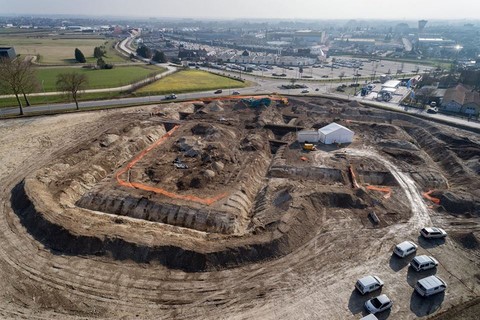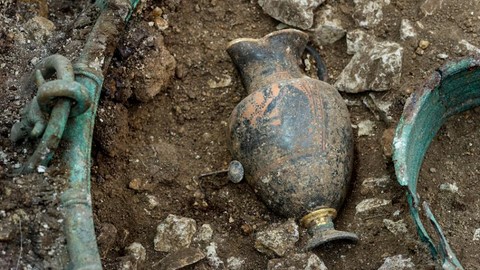A 5th century BC Celtic princely tomb in Champagne
Archaeologists with the French INRAP (National Institute for Preventive Archeaological Research) have been excavating a 5th Century BC tomb of a Celtic prince near Troyes. Finds so far have been spectacular.
It’s an « exceptional discovery ,» announces INRAP. Since October, archaeologists of the INRAP (National Institute for Preventive Archaeological Research) have been excavating a Celtic tomb of the 5th century BC, of an undeniably princely character, conveyed as much by its sheer dimensions as by the « quality of the material brought to light. »
At the center of a tumulus 40 meters in diameter, the defunct is resting with his carriage at the heart of a 14 sqm funereal chamber, the largest on record for this period.

The excavation site is situated in the commercial and small-businesses zone of the village of Lavau, in the Aube département, in the Champagne region, a few kilometres from the city of Troyes. "The place doesn’t look very impressive, » as described by Le Monde, « it borders on a traffic circle » not far from the prefabs of the commercial zone. The building of a sipermarket had been planned on the spot.
The tomb dates back to the Early Iron Age, defined as the Hallstatt, between 800 and 450 B.C., most probably to the end of this period, at the transition with the La Tène period. It belongs to a vast necropolis including Bronze Age tombs, Iron Age tombs and even Gallo-Roman ones.
The furnishings impress through the great refinement of the objects they have yielded, which are of Greek, and probably in some cases of Etruscan origins, and are all connected with wine service.
The most important piece is a large bronze cauldron into which wine was mixed with water. Its four annular handles are decorated with heads of Acheloos, the Greek river-god, perfectly recognizable by his horns, his beard, his moustache and his bull’s ears. The lip of the cauldron is decorated with feline heads which might have been fashioned by Etruscan artists, according to archaeologist Emilie Millet.



The cauldron contained a wine pitcher (oenochoé) in Attic ceramic with black figures, made by Greek artists. One scene represents Dionysius facing a female character. Remarkably well preserved, this pitcher is enhanced with gold around the lip and the foot, something which the Greek did not do for themselves. “It has been customized with gold, in order to please the Barbarians,” according to the analysis of Dominique Garcia of INRAP.
Below the cauldron, was found a sieve made of gilded silver, and containers into which to pour the wine.
"We are probably dealing with a local Celtic « prince,” Dominique Garcia points out. The archaeologists have found a large knife in a scabbard, which seems to point to the defunct being a man.
In another tomb nearby, the skeleton of a woman has been found. “We know that this tomb has been built before that of the Prince. But it is quite possible that there were links of kinship between the two persons,” guesses Bastien Dubuis, the dig's manager.
There exists a "corpus" of tombs of this type, according to archaeologist Sandra Péré-Noguez, which were discovered over past decades in Eastern France and Southern Germany, considered to be the cradle of the Celts at this period, which renders the discovery of this tomb so far West, near Troyes, even more surprising.
The best known of these earlier discovered tombs is the one of the Lady of Vix, in Côte-d'Or, Burgundy, discovered in 1953, which yielded the famous krater of Vix, the largest metal container known from Western Classical Antiquity, but most of them are found in Germany, such as the tomb of Hochdorf, which was investigated in 1979.
One element puzzles Sandra Péré-Noguez particularly: "on the cauldron, there is a lion resembling very closely one found on another container excavated at Hochdorf. The analysis of this discovery promises some interesting parallels and interpretations."
"The funereal furnishings testify to the existence of trading activities between the Mediterranean and the Celts, » stresses Dominique Garcia.
The end of the 6th century and the beginning of the 5th century BC saw the economic development of the Etruscan and Greek city-states in the West, such as Marseilles.
On the look-out for slaves, metals and precious goods (tin, amber…) the Mediterranean tradesmen entered into contact with the continental Celtic communities.
The Celtic communities holding sway over the natural axes of communications along rivers such as the Seine, the Rhône, the Saône, the Rhine, the Danube profited most. «These were some sort of diplomatic gifts, » according to Dominique Garcia. "Their far-away provenance probably explains their presence in the tombs: besides their preciousness, they have also a very high political and symbolic value," says Péré-Noguez.
The excavations of INRAP ended in March. It seems that the skeleton of the defunct has been retrieved and is currently investigated in laboratories. One awaits the results eagerly.
Anne-Marie de Grazia, from various articles in Le Nouvel Observateur.

